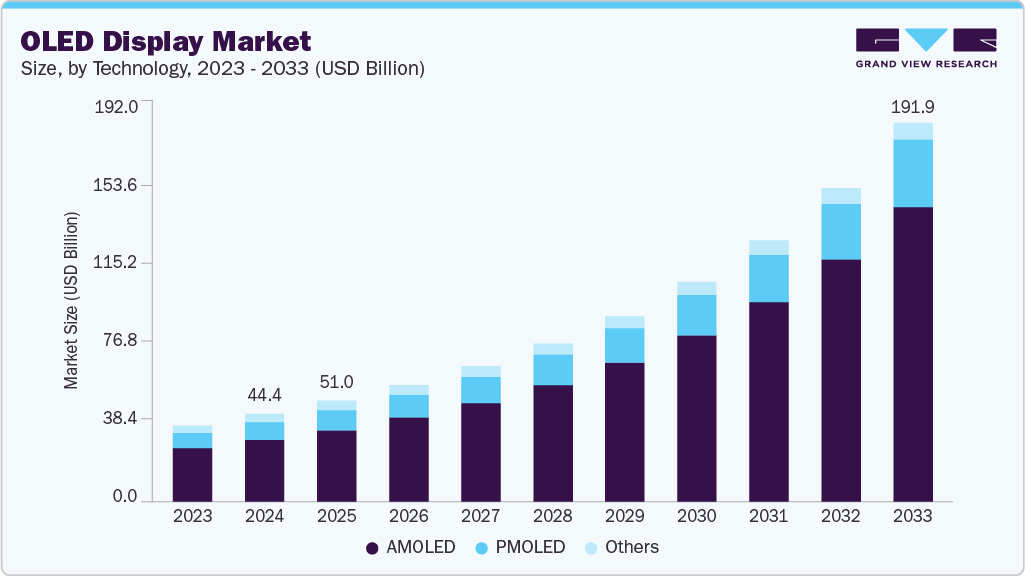- Home
- »
- Agrochemicals & Fertilizers
- »
-
Seed Treatment Market Size, Share & Growth Report, 2030GVR Report cover
![Seed Treatment Market Size, Share & Trends Report]()
Seed Treatment Market (2023 - 2030) Size, Share & Trends Analysis Report By Type (Insecticides, Fungicides), By Crop (Corn, Wheat, Soybean), By Region (North America, Asia Pacific), And Segment Forecasts
- Report ID: 978-1-68038-167-2
- Number of Report Pages: 100
- Format: PDF
- Historical Range: 2018 - 2021
- Forecast Period: 2023 - 2030
- Industry: Bulk Chemicals
- Report Summary
- Table of Contents
- Segmentation
- Methodology
- Download FREE Sample
-
Download Sample Report
Seed Treatment Market Summary
The global seed treatment market size was estimated at USD 13.4 billion in 2022 and is expected to projected to reach USD 26.84 billion by 2030, growing at a CAGR of 9.46% from 2023 to 2030. This is attributed to the increasing usage of seed treatment therapy in crop production industry for increasing seed resistance against pests and insects due to their high effectiveness.
Key Market Trends & Insights
- Asia Pacific dominated the industry in 2022 and accounted for the largest share of more than 32.0% of the overall revenue.
- Based on crop, the corn segment dominated the global industry in 2022 and accounted for the maximum share of more than 31.7% of the overall revenue.
- Based on type, the insecticides type segment dominated the global industry in 2022 and accounted for the maximum share of more than 32.8% of the overall revenue.
Market Size & Forecast
- 2022 Market Size: USD 13.4 Billion
- 2030 Projected Market Size: USD 26.84 Billion
- CAGR (2023-2030): 9.46%
- Asia Pacific: Largest Market in 2022
The seed treatment also increases the strength of leaf and fruit destroying various insects and pests. Seed treatments are used to increase the strength of seeds as well as increase the yield of agricultural products. Demand for the seed treatment is growing in agricultural practices as it helps prevent seed and soil borne infections and diseases. In addition, it reduces germination time, enhances overall productivity, and improves crop yield. Growing health concerns in crops and fruits regarding its yield is increasing the use of seed treatment activities. This has also been contributing to the growth of the global seed treatment market.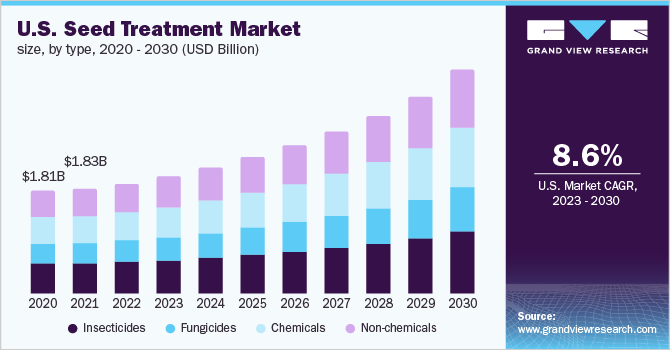
Seed treatments are used as an effective remedy against seed-borne and soil-borne diseases, the soil born diseases can get infested the plant’s roots. The development of organic treatment for seeds provides zero residues of hazardous chemicals in grains and agricultural products, and growing consciousness for high agricultural yield has increased demand for the seed treatment in the market.
Increased usage of seed treatment, especially in developing economies for higher yields in fruits & vegetable crops has been observed recently, and this trend is anticipated to continue further worldwide owing to the increasing demand for fruits & vegetables. The rising demand-supply gap is negatively impacting growth of the industry, thereby increasing the prices of insecticides and pesticide products.
High demand for protecting and increasing high-yield crops, globally, is increasing demand for the seed treatment. Developed economies like the U.S and Europe garner major agriculture product markets and are one of the major producers of high-quality agricultural products. The increase in demand for integrated pest-management practices, seed treatment, pest resistance, and organic farming practices, and to reduce post-harvest crop losses have increased the usage of bio-based seed treatment activities.
A surge in the production and export of high-quality agricultural products in emerging economies of Asia Pacific is expected to contribute to the demand for seed treatment. This, in turn, is anticipated to fuel growth of the global industry during the forecast period.
The usage of bio-based seed treatment helps in tackling the issue of climate change and global warming. It replaces chemicals of various types and ensures a clean environment. The growing usage of seed treatment in agricultural practices is expected to fuel market growth in the coming years. The global demand for seed treatment was not reduced completely during the pandemic considering their end-use types in the agricultural sector as a repellent against soil-borne and seed-borne diseases.
The market for seed treatment witnessed substantial growth in 2022 and this trend is expected to continue in the coming years, considering the ongoing research and development activities in the industry.
Crop Insights
Based on crop, the industry has been further categorized into corn, soyabean, wheat, canola, and others. The corn segment dominated the global industry in 2022 and accounted for the maximum share of more than 31.7% of the overall revenue. The growth of this segment can be attributed to the high product demand from crop protection activities. Seed treatment is basically seeded nourishment activity using bio-based and synthetic-based chemicals.
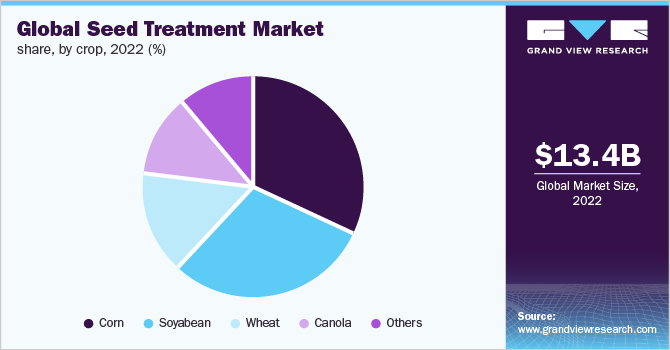
Seed Treatment for seed treatment is living organisms that can interrupt the life cycle of insect pests in such a way that crop damage can be minimized in the future. The agents employed as bio-based seed treatment include predators, parasites, and, disease-causing fungi bacteria, and viruses, which are the natural enemies of pests and insects
The global market for bio-based seed treatment is still very small as compared to the overall seed treatment market. On the other hand, synthetic seed treatments are largely used and are manufactured at a relatively cheaper cost than bio-based pesticides and insecticides. So, achieving that economy of scale is a tough challenge to overcome for the participants operating in the market.
However, the rapid adoption rate of bio-based seed treatment is expected to help their cause. Asia Pacific led the overall market for seed treatment and accounted for more than one-third of the global market alone. However, owing to stringent regulations regarding the use of synthetic pesticides and insecticides make Europe the most attractive market in the near future.
Type Insights
Based on type, the global industry has been further categorized into insecticides, fungicides, chemical, and non-chemicals. The insecticides type segment dominated the global industry in 2022 and accounted for the maximum share of more than 32.8% of the overall revenue. The growth of insecticides can be attributed to the increasing demand from emerging economies of Asia Pacific, such as India and China.
From past decade the use of bio-based seed treatment is increasing, due to the zero residues obtained in agricultural products, after the Type of bio-based seed treatment products. The type of seed treatment promotes the annihilation of pests and insects from the seeds and soils without forming any hazardous chemical residue in vegetables and fruits. Farmers of the North American and European region are some of the early adopters of seed treatment products, as the major consumers from this region prefer organic-based agricultural products.
Regional Insights
Asia Pacific dominated the industry in 2022 and accounted for the largest share of more than 32.0% of the overall revenue. The region is likely to expand further at a steady CAGR maintaining its leading position throughout the forecast period. The growth is attributed to the increased agricultural activities in the region coupled with high crop demand from the major countries, such as the U.S., and countries of the European region.
In Europe, the major driver for the market growth is the product usage in vegetable & fruit plantations owing to the ongoing agricultural and fruit & vegetable plantation development projects across the countries, such as Germany, France, the U.K., and Italy. According to a study by the European Commission, the agriculture sector contributed revenue of EUR 178.4 billion in 2020.
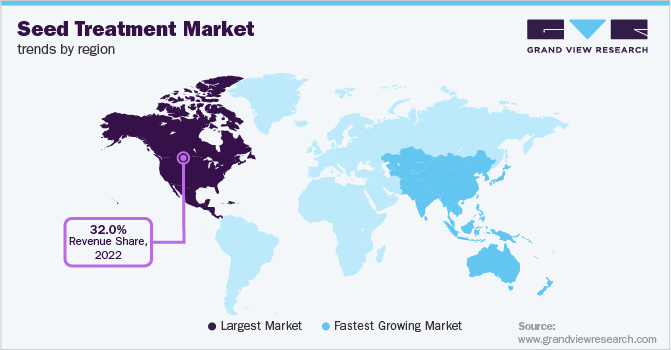
Asia Pacific, on the other hand, is expected to register the fastest growth rate during the forecast years. The region accounted for the second-largest revenue share of the global industry in 2022. Organic agricultural practices in the Asia Pacific region are expected to witness substantial growth in the coming years. This is driven by the increasing demand for the bio-based agricultural products, which is anticipated to boost regional market growth during the forecast period.
Key Companies & Market Share Insights
The presence of many multinational players in the industry has resulted in high competition. These companies look forward to expanding their operations in untapped markets to generate higher revenues. Major manufacturers undertake various initiatives, such as mergers & acquisitions, joint ventures, and expansion activities, to meet the rising product demand. Through these initiatives, companies also seek to increase their global footprints and expand their reach to potential customers at optimum distribution costs.Some of the prominent players in the global seed treatment market include:
-
Syngenta
-
Bayer
-
Syngenta AG
-
Monsanto
-
BASF
-
Crop Science
-
Chemtura
-
DuPont
-
Nufarm
Seed Treatment Market Report Scope
Report Attribute
Details
Market size value in 2023
USD 14.25 billion
Revenue forecast in 2030
USD 26.84 billion
Growth rate
CAGR of 9.46% from 2023 to 2030
Base year for estimation
2022
Historical data
2018 - 2021
Forecast period
2023 - 2030
Quantitative units
Volume in thousand tons, revenue in USD million and CAGR from 2023 to 2030
Report coverage
Revenue forecast, company ranking, competitive landscape, growth factors, trends
Segments covered
Type, crop, region
Regional scope
North America; Europe; Asia Pacific; Central & South America; Middle East & Africa
Country scope
U.S.; Canada; Mexico; Germany; U.K.; Italy; Spain; China; India; Japan; Brazil; Argentina; Saudi Arabia; South Africa
Key companies profiled
Syngenta; Bayer; Monsanto; BASF; Crop Science; Chemtura; DuPont; Nufarm
Customization scope
Free report customization (equivalent up to 8 analyst’s working days) with purchase. Addition or alteration to country, regional & segment scope
Pricing and purchase options
Avail customized purchase options to meet your exact research needs. Explore purchase options
Global Seed Treatment Market Segmentation
This report forecasts revenue growth at global, regional, and country levels in addition to provides an analysis of the latest industry trends in each of the sub-segments from 2018 to 2030. For this study, Grand View Research has segmented the global Seed Treatment Market report based on the type, crop, and region:
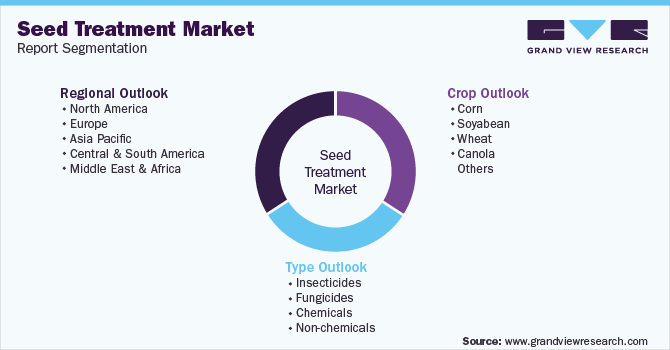
-
Type Outlook (Volume, Thousand Tons; Revenue, USD Million, 2018 - 2030)
-
Insecticides
-
Fungicides
-
Chemicals
-
Non-chemicals
-
-
Crop Outlook (Volume, Thousand Tons; Revenue, USD Million, 2018 - 2030)
-
Corn
-
Soybean
-
Wheat
-
Canola
-
Others
-
-
Regional Outlook (Volume, Thousand Tons; Revenue, USD Million, 2018 - 2030)
-
North America
-
U.S.
-
Canada
-
Mexico
-
-
Europe
-
Germany
-
U.K.
-
Spain
-
Italy
-
-
Asia Pacific
-
China
-
India
-
Japan
-
-
Central & South America
-
Brazil
-
Argentina
-
-
Middle East & Africa
-
Saudi Arabia
-
South Africa
-
-
Frequently Asked Questions About This Report
b. The global seed treatment market is anticipated to grow at a compounded annual growth rate (CAGR) of 9.46% from 2023 to 2030 and reach USD 26.84 billion by 2030.
b. On the basis of type, the global industry has been further categorized into insecticides, fungicides, chemical, and non-chemicals. The insecticides type segment dominated the global industry in 2022 and accounted for the maximum share of the overall revenue.The growth of on the insecticdes can be attributed to the increasing demand from emerging economies of Asia Pacific, such as India and China.
b. Some of the major players in seed treatment market are Syngenta, Bayer, Monsanto, BASF, CropScience, Chemtura, DuPont, and Nufarm..
b. Growing demand can be attributed to increasing usage of seed treatment therapy in crop production industry for increasing seed resistance against pests and insects due to their high effectiveness. The seed treatment also increases the strength of leaf and fruit destroying various insects and pests
b. The global seed treatment market size was estimated at USD 13.4 billion in 2022 and is expected to reach USD 14.25 billion in 2023.
Share this report with your colleague or friend.
Need a Tailored Report?
Customize this report to your needs — add regions, segments, or data points, with 20% free customization.

ISO 9001:2015 & 27001:2022 Certified
We are GDPR and CCPA compliant! Your transaction & personal information is safe and secure. For more details, please read our privacy policy.
Trusted market insights - try a free sample
See how our reports are structured and why industry leaders rely on Grand View Research. Get a free sample or ask us to tailor this report to your needs.










